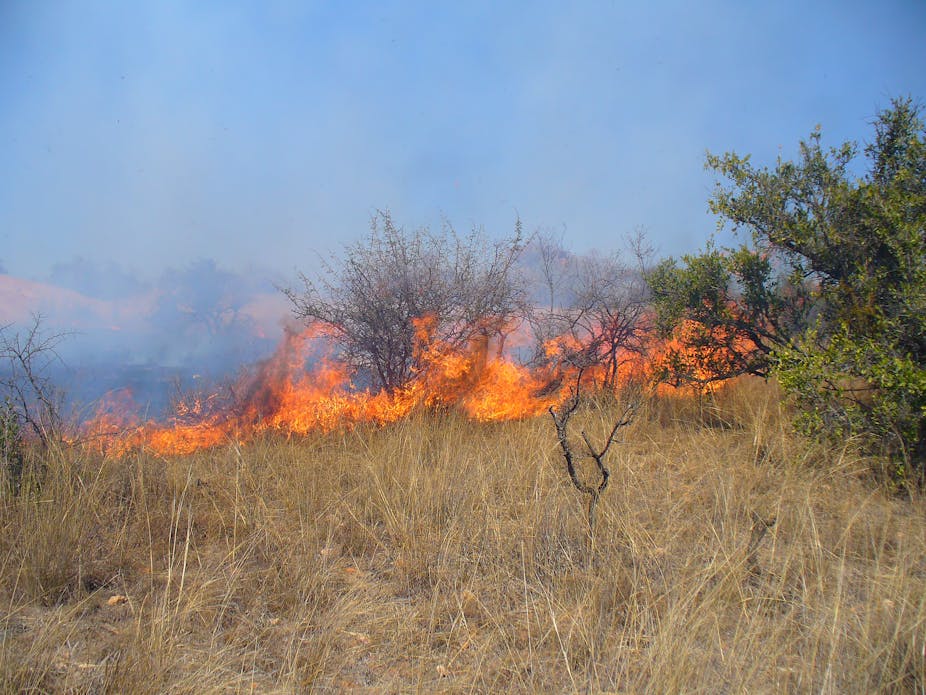-Fires are often seen as destructive. But when used properly it can be a force for good. For example, the floral biodiversity of savanna ecosystems is largely driven by fire activity. South Africa’s fynbos region – a floral region with plants unique to South Africa – is also highly dependent on fires to manage water and nutrient resources.
Of course, fire can also have a negative effect on the environment. Air quality can be damaged by the release of carbon monoxide and ozone and the release of carbon dioxide and other greenhouse gases during the burning of biomass (organic matter) has been linked to climate change.
Scientists have spent a great deal of time and effort trying to understand fire activity and how it relates to vegetation communities, topography and – of great concern in recent years – climate change.
Traditionally, research has been limited mainly to smaller geographical areas of interest and short observation periods. But recent developments in satellite based remote sensing have created the opportunity to study fire actively over large regions. For example, past research in South Africa has focused largely on national parks. With remote sensing technology, scientists can now gain insights into the fire dynamics of rural areas.
This technological advancement helped us investigate fire dynamics over larger areas of South Africa. We combined the data with an investigation into the years which experienced abnormal air temperature and rainfall characteristics to gain a meaningful insight into the relationship between climate change and fire activity.
Climate change and fire activity
The relationship between climate change and fire activity can be quite complex. But two simplified scenarios have been established by the International Panel on Climate Change and associated climate scientists.
When air temperatures are above the global mean of 14 °C, heat waves and drought conditions may be more severe. This may cause vegetation to desiccate at higher rates. That leads to drier fuel loads, the amount of vegetation that can potentially be ignited, and ultimately, more fires.
Under a warming climate, rainfall may be significantly higher. This leads to heavier fuel loads, which causes more available fuel to burn and also increased rates of spread when fires occur.
There’s also a feedback mechanism between climate change and fire activity. Increased fire activity will release greater concentrations of greenhouse gases. This can result in an enhanced greenhouse effect, which in turn can cause further increases in fire activity.
A recent study found an increase in the length and severity of fire seasons across the globe. The study revealed that contemporary changes in the global climate has resulted in increased periods of fire danger. These changes indicate that fire activity is likely to increase in a warming climate. The study also pointed to the dangers of increased fire in South Africa.
Persistent fire weather season length increases in ecosystems such as South Africa’s Mediterranean fynbos could lead to more frequent severe burning conditions and more area burned, shortening fire return intervals and threatening these biodiversity-rich shrublands.
For example, climate change and short-term climate variability such as La Niña – which is characterised by colder ocean temperatures – could lead to increased fire activity in South Africa.
The threat in South Africa
Fires are already a regular feature of the South African landscape, as they are across Africa, which is nicknamed the “Fire Continent”.
Between 2003 and 2014, the greatest number of fires in South Africa occurred in 2005, 2007 and 2010.
2005 and 2010 have been cited as two of the warmest years on record in the southern hemisphere compared to a global average. We can assume that South Africa’s annual average air temperatures would be similar to those in the southern hemisphere as a whole. This therefore suggests that there’s a relationship between a spike in the number of fires in 2005 and 2010 and the above-average air temperature measured in those years.
The increase in fires in 2007 may be linked to the fact that in 2006 the most recent La Niña led to increased rainfall over the eastern half of South Africa. In turn this may have led to increased vegetation growth during the 2007 winter. This is also the eastern region’s fire season, hence an increase in the number of fires.
But caution should be exercised when linking climate change to regional phenomena, particularly given that rainfall, vegetation and even topography can vary widely.
Recent years do support the hypothesised effects of climate change on South African fires. But further long-term statistical analyses need to be done to develop a deeper understanding of the effects of climate change on fire activity on a regional and local level.

